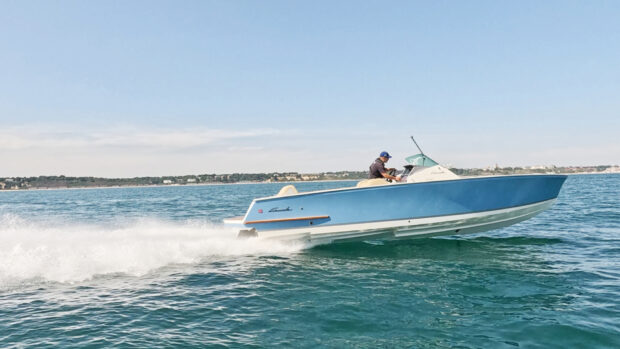Our resident boating instructor Jon Mendez explains how to make fast turns safely...
Driving a fast boat safely will always involve making turns, either pre-planned ones to reach your destination or when avoiding other craft, debris or waves.
Practising turning the boat at speed so that you know how much helm, throttle and trim to use before it starts to skip sideways is crucial to avoid endangering yourself, your crew and your vessel.
The key to a safe, high speed turn is a smooth coordination of hands, throttle, trim and vision to minimise changes in the balance and attitude of the boat.
A sudden decrease in power will pitch the weight forward, pushing the bow deeper and raising the stern, increasing the chance of losing grip at the stern.
Conversely, a sudden increase in power will raise the bow and lower the stern. Turning with any sudden change of direction will increase the angle of heel, this change in speed and lateral g-force will further test the hull’s ability to maintain its grip on the water and the heel will bring the propeller(s) closer to the surface, making it easier for them to suck in air.
Article continues below…

How to throttle and trim an outboard engined boat

VIDEO – How To: Helm in a beam sea
In our latest How To guide we demonstrate how to trim your boat if you are travelling in a beam
This aeration when turning can also trigger hull slide. Ultimately, if you are heavy-handed with the controls, you are more likely to induce hull slip or even a “hook”, when the stern loses all grip, the bow digs in and the whole boat pivots rapidly and violently around it with dramatic and sometimes dangerous results.
The ability to turn the boat smoothly and consistently is key to maintaining speed and safety. I like to break this down into three steps.
1. Look
You should be keeping a good look-out at all times anyway but before turning you need to look intently, not just at where you are going but at the water you intend to turn onto.
Is it clear of other boats and debris? Is it flat with no breaking waves or peaks that could upset the boat? Most importantly, do not just look at the bow, instead, look and steer where you want to go. The boat will follow.
2. Trim
The boat/engine needs to be trimmed down a bit from where it was before the turn. If you’re running upwind, you may already have it trimmed down so it could just need a small adjustment.
However, if you’re heading downwind or in flat conditions with the engine trimmed up then you will need to trim it down enough to increase the propeller’s bite.
3. Throttle
It’s good practice to ease the throttle before the turn, not by much as this risks upsetting the balance, just enough to let the bow settle.
Now turn the helm with a steady motion. Any turn slows the boat, so as you turn, gently increase the throttle so that you are maintaining a steady bow angle. Too much throttle and the bow will rise, too little and it will fall.
Lastly, as you start to exit the turn and straighten the wheel, add more throttle to lift the bow and accelerate away.
If you enjoyed this…
Be first to all the latest boats, gadgets, cruising ideas, buying advice and readers’ adventures with a subscription to Motor Boat & Yachting. Available in both print and digital formats, our monthly magazine will be sent directly to your home or device at a substantial discount to the usual cover price. See our latest offers and save at least 30% off the cover price.










